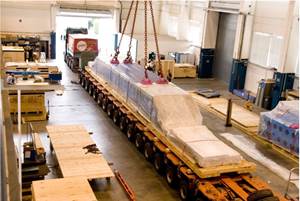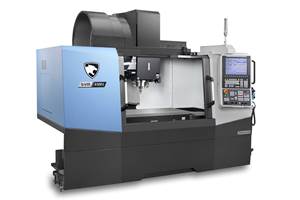Before You Buy That New Machine Tool, Consider the Workpiece
Among the many important questions to answer before purchasing a new machine tool is what size and sort of workpiece it will be machining.
There are many factors to be considered before acquiring a new machine tool, and a lot of questions have to be asked and answered prior to selecting the right CNC machine. Some good first questions are “Why buy the machine in the first place?” and “What is the buyer trying to accomplish in making the purchase?” Answering these big-picture questions will help ensure a successful installation once a machine is purchased, but there are more important factors to consider, including what parts will be made on the machine.
Buy with Room to Grow
Once the reason for purchasing the machine has been established, but before machine type or model selection can begin, the technical aspects of the machine come into play, and the most basic but critical questions that must be addressed are:
- What size are the parts to be machined?
- Will the machine process tiny parts, large parts or really huge parts?
The answer to these questions will help determine the appropriate size and model of machine.
In a job shop environment where parts of a multitude of sizes and shapes will be machined, and where the requirements might change from day to day, the buyer should consider the largest part that might need to be machined. What size parts will the shop be running tomorrow or next week? Future shop capacity also should be considered in selecting the optimum machine size. Perhaps a shop could secure more business if it had a slightly larger machine. It’s easier to step up to a larger model today, allowing for the possibility of bigger or longer parts to be machined tomorrow, rather than purchase a smaller machine and regret that decision six months later.
The weight of the parts to be machined also should be considered as well as the size and weight of the fixtures to be used. Every vertical or horizontal machining center has a maximum allowable weight that can be placed on the table, but there are other machine tool designs in which the machine base has virtually no weight limit.
Part Shape Shapes Your Choices
Also of utmost importance to selecting the right machine for a particular operation is the geometry and shape of the parts to be machined. Part geometry has everything to do with how the part will be held during the machining process, which will greatly influence the type of holding device or fixtures to be used. Will a simple table chuck do the job, or is a more sophisticated or dedicated fixture, vacuum or hydraulic chuck required? Perhaps the part geometry will require a rotary table for fourth- or fifth-axis machining; and if a rotary table or fixtures are added, the X, Y and Z machine travels must be adequate to hold both the fixtures and the parts combined.
More geometrically complex parts may require a multi-axis machine with full five-axis 3D-machining capabilities, whereby the machine can move in five axes simultaneously, rotating on two additional A and B axes. This enables the cutting tool to approach the part from multiple planes and a variety of directions, reducing the need for multiple operations and additional setups. Part accuracy and repeatability are capabilities that are critical to ensuring the machine’s success.
It’s also important to consider the number of cutting tools required to machine the parts, as well as their length, diameter and weight. The machine’s toolchanger must also have an adequate number of tooling pockets to hold the necessary number of tools.
Do Your Research
Inevitably, all machine buyers get to the point in the process of comparing machine types and machine models. Techspex.com, a free research center and analysis tool, can help anyone find the right machine for the job. This handy website database contains more than 500 machine tool brands with more than 8,600 models of every machine type imaginable—all in one place. Techspex maintains the deepest, most up-to-date machine tool information, whether the equipment is a milling, turning, grinding, EDM or coordinate measuring machine —it’s all there. Simply enter the basic attributes and specifications that are required, and the system will provide a side-by-side comparison by machine type, model and builder.
This is part two of a three-part series about buying machine tools.
- Part one: So You’re in the Market for a Machine Tool—Start Your Search by Asking “Why”
- Part three: Why Forming a Machine-Tool Buying Committee Is a Good Idea
Find more insights about acquiring a new machining center by visiting the Techspex Knowledge Center, “Guide to Buying Machine Tools.”
This blog post was adapted from an article by Barry Rogers published in the Machine/Shop supplement to Modern Machine Shop magazine.
Related Content
5 Tips for Running a Profitable Aerospace Shop
Aerospace machining is a demanding and competitive sector of manufacturing, but this shop demonstrates five ways to find aerospace success.
Read MoreHeavy Engineering: The Complex Logistics of Moving Large Machine Tools
One of our fascinations with large-format machine tools has little to do with their capabilities, but everything to do with the logistics involved with getting them up and running. Here’s how one of the world’s oldest builders of giant machine tools tackles the challenge.
Read MoreWatchmaking: A Machinist’s View
Old-world craftsmanship combines with precision machining on a vertical machining center and Swiss-type lathe to produce some of the only U.S.-made mechanical wristwatch movements.
Read MoreDN Solutions Introduces High-Productivity Vertical Machining Center
The SVM 5100L’s performance has been optimized to reduce the acceleration/deceleration times of the XYZ axes and spindle, reducing non-cutting time.
Read MoreRead Next
So You’re in the Market for a Machine Tool—Start by Asking “Why?”
There’s nothing worse than buying a new machine that ends up neglected in the corner because it’s the wrong one for the job. Some key questions at the beginning of your search can help you avoid that.
Read More3 Mistakes That Cause CNC Programs to Fail
Despite enhancements to manufacturing technology, there are still issues today that can cause programs to fail. These failures can cause lost time, scrapped parts, damaged machines and even injured operators.
Read More
















.png;maxWidth=300;quality=90)








